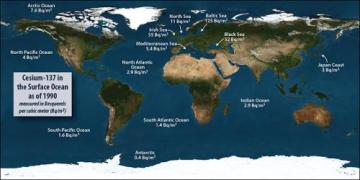After an eight-year study of radioactive waste cleanup in Washington, the Department of Energy faces complaints that an incomplete disposal solution has been offered.
Last March, the world watched closely as Japan struggled to contain a series of equipment failures, hydrogen explosions and releases of radioactive materials at the Fukushima Daiichi Nuclear Power Plant.
More than 10 years after electricity deregulation, the nuclear power industry has decreased greenhouse gas emissions by nearly 40 million metric tons of carbon dioxide and saved $2.5 billion a year as a result of operating more efficiently over the past decade, according to a new study.
Worldwide energy consumption is projected to grow by 53 percent between 2008 and 2035, with much of the increase driven by strong economic growth in the developing nations especially China and India, according the Energy Information Administration’s International Energy Outlook 2011.
Their estimate, reported this week in the online edition of the Proceedings of the National Academy of Sciences, is based on a signal sent across the Pacific Ocean when operators of the damaged reactor had to resort to cooling overheated fuel with seawater.
Scientists from The University of Manchester have been selected to undertake vital safety work on the next generation of the world’s nuclear reactors.
Researchers at the University of Illinois have recorded an airglow signature in the upper atmosphere produced by a tsunami using a camera system based in Maui, Hawaii.
A report ordered by Congress in 2005 on the connection between U.S. energy production and demands on water supplies is the target of a Freedom of Information Action lawsuit filed by Civil Society Institute against the U.S. Department of Energy.
Shifting from nuclear to other types of power plants could affect the reliability of the electricity supply, electricity costs, air pollution, carbon emissions, and the reliance on fossil fuels like coal and natural gas, the researchers said.
Fallout from the March Fukushima nuclear plant leak reached into Italian government policy, as it now appears likely there will not be a renewed thrust toward the controversial power source anytime soon.
The Woods Hole Oceanographic Institution will lead the first international, multidisciplinary assessment of the levels and dispersion of radioactive substances in the Pacific Ocean off the Fukushima nuclear power plant—a research effort funded by the Gordon and Betty Moore Foundation.
While spent nuclear fuel continues to pile up by the ton across the United States, UC Irvine’s Mikael Nilsson says the solution is clear: recycle it at the commercial nuclear power plants that create it.
A University of Sheffield professor has found a way of locking up iodine radioisotopes in a durable, solid material suitable for ultimate disposal, such as lead iodovanadinite(Pb5(VO4)3I).

Radionuclides in seawater have been reported from the Fukushima plant's discharge canals, from coastal waters five to 10 kilometers south of the plant, and from 30 kilometers offshore, that are at least an order of magnitude higher than the highest levels in 1986 in the Baltic and Black Seas, the two ocean water bodies closest to Chernobyl.
Taking a close look at information disclosed by Japanese government ministries, the World Health Organization, the International Atomic Energy Agency and others, Professor Wakeford details events at the six different reactors, and the consequent releases of radioactivity.
The recent nuclear accident in Fukushima Daiichi in Japan has brought the nuclear debate to the forefront of controversy. While Japan is trying to avert further disaster, many nations are reconsidering the future of nuclear power in their regions.

The studies would include a tsunami hazard analysis as well as reprocessing and reanalyzing existing data using more modern digital and numerical computer processes.
Starting materials developed at the Los Alamos National Laboratory may be candidates for advanced nuclear fuels.
The product, based on materials used to clean up Three Mile Island's nuclear disaster, reportedly removes radioactive isotopes from aqueous solutions.
EPA has updated its emissions and generation database, or eGrid, with 2007 data, allowing users to access the information using ZIP codes.